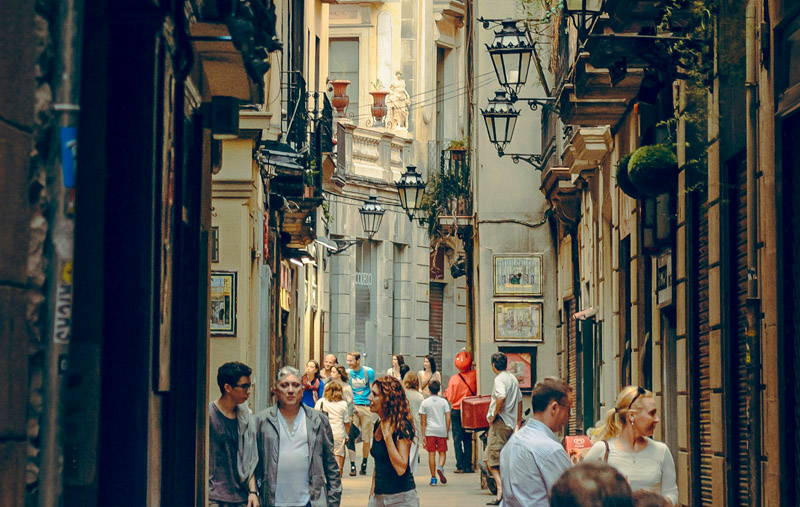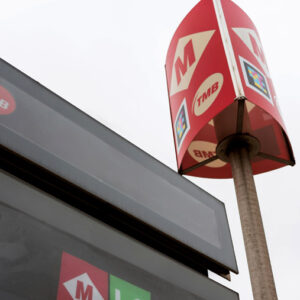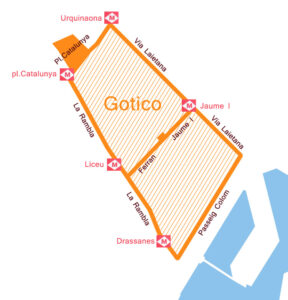The Gothic Quarter in Barcelona or Barrio Gothico is the most popular tourist area. There are many sights, marked in all the world’s guides, shops with a wide variety of goods, from exotic to the products and goods of everyday demand, you can find cafes, bars and restaurants for every taste. And, of course, it is impossible not to fall under the charm of narrow streets with old houses, each of which has its own face and its own history. You can explore the Gothic Quarter more than one day with unwavering pleasure. However, some issues may arise.

For a tourist who is in Barcelona for the first time, the Gothic Quarter can become a maze from which it is not so easy to get out. There are situations when there is no possibility to navigate using the map in the smartphone and there is not a paper card at hand. When you consider the lack of knowledge of foreign languages, the situation may not appear to be very pleasant. Each individual will cheerfully explain how to get to the spot you have specified, but he is unlikely to do it in English. In our scenario, determining the north by the growth of the moss on the trees or the south by the location of the sun at noon is clearly ineffective. What if you’ve already walked enough and want to relax in your hotel room, but even getting to the nearest metro station is a difficult task? In this case may be useful to know the specifics of the organization of urban space in the Gothic Quarter area.
The Gothic Quarter consists of narrow streets. Most of them do not have a division into a sidewalk and a roadway. The most important thing for us is that there is unilateral traffic on all these streets. The only streets in Gothic with bilateral traffic and higher sidewalk are Carrer Ferran and Carrer Jaume I. Carrer is a street in Catalan. Carrer Ferran and Carrer Jaume I go in the same direction, they are actually one street that divides the Gothic Quarter in half. In the middle of the neighborhood, where one street meets the other, there is a small square of Sant Jaume with beautiful government buildings. If you find yourself on one of these streets, you will quickly reach the boundary of the Gothic Quarter, moving along them in any direction you choose. Carrer Jaume I will take you to Via Laetana, a wide street with bilateral traffic. The metro station is located at the intersection of Carrer Jaume I and Via Laetana. Carrer Ferran will take you to the most famous tourist street La Rambla, which means Boulevard. La Rambla is a wide boulevard with bilateral traffic. If you turn from Carrer Ferran on La Rambla to the right, then in a minute you will reach the entrance to the Liseu metro station.
From this particular case we go to the general rule that will help you navigate if you are in the Gothic Quarter of Barcelona. The Gothic Quarter is bounded by wide streets with bilateral traffic, you cannot leave it without crossing these streets. If you look at the map, it’s Via Laetana on the right and La Rambla on the left. In the upper part, the Gothic Quarter rests on the Plaza Catalunya, and at the bottom ends the Passeig de Colom, which means the avenue of Columbus. Paseo de Colom is a wide street with bilateral traffic that runs along the port. The bottom side of the quarter and the top side are not just the position on the map. It’s a topographic fact. The Plaza Catalunya is higher above sea level than the Paseo de Colom. Therefore, Via Laietana and La Rambla descend slightly toward the sea.
To get to the nearest subway, you have to move in any direction you choose, without turning if possible. If you go to the Via Laetana at any point, you have to turn left and go up. You can quickly reach the Jaume I metro station in the middle of the street or the Urkinaona metro station at the top of the street.
If you’re on the La Rambla at any point, you have to turn right and go up, too. You can quickly reach the Liseu metro station in the middle or the Plaza Catalunya metro station at the top of the street. There are two other options: Plaza Catalunya and Paseo de Colom. It is impossible to get to Plaza Catalunya without noticing it, what remains is to find one of several entrances to the Metro of the same name. If we go out on the Passeig de Colom, we have to turn right and get to the point where it crosses with La Rambla. At the bottom of La Rambla is the entrance to the Drassanes metro station.
Thus, from any point of the Gothic Quarter, you can reach the metro station or street where you can catch taxi cab in a maximum of 10 minutes. I wish you a pleasant walk in the ancient heart of Barcelona!



